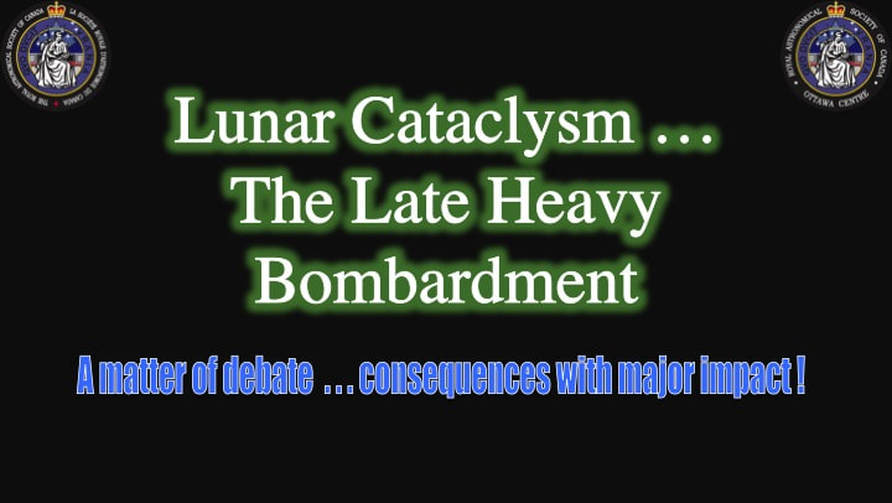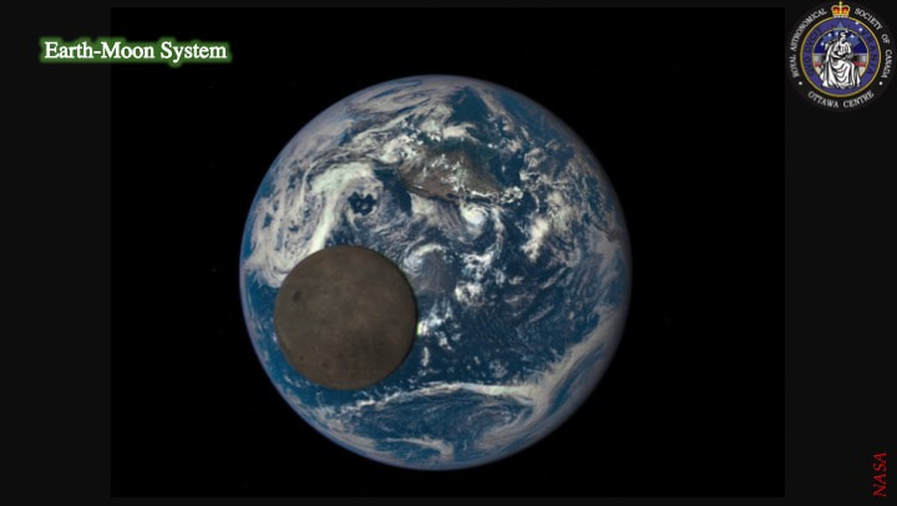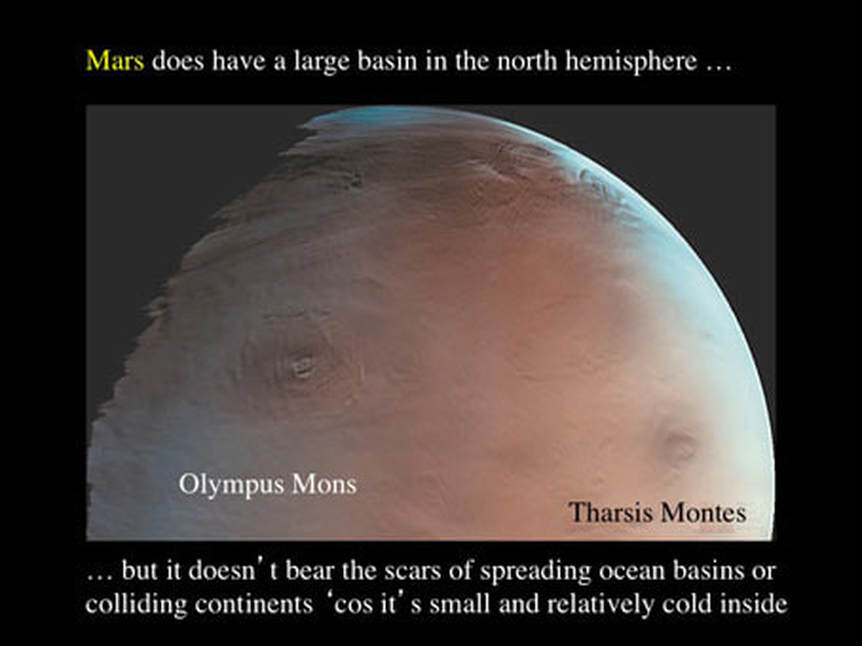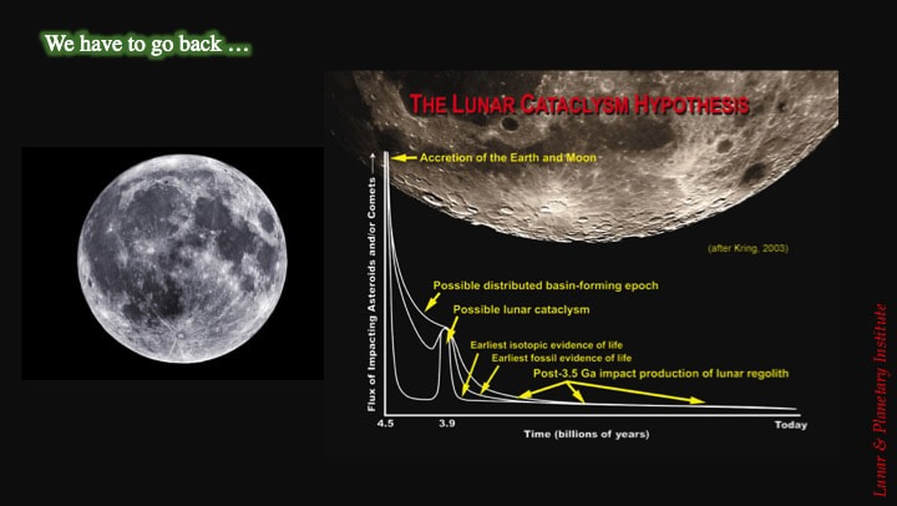|
LUNAR CATACLYSM
|
As I pointed out in my presentation on Lunar Origins, some scientists have been making some pretty well developed arguments that strongly suggest we need to pay more attention to our Moon. In fact, according to them, our scientific understanding of the Solar System has evolved to such a point that we need to go back to the Moon – now - in order to test key aspects of our models of planetary body formation. Their point is that the modern consensus regarding the origin and early evolution of our Moon has been much less of a consensus than you might think, and it’s about time to sort things out.
In my presentation on Lunar Origins, I addressed the first of two aspects of this consensus; the on-going debate regarding the origin of the Moon during a collision of a Mars-size impactor with the primordial Earth at ~4.6 Ga. Here, I want to examine another aspect of this supposed consensus: the subsequent impact activity on the Moon as part of a Solar System-wide Late Heavy Bombardment at ~3.9-3.8 Ga.
Let me be clear. Yes indeed, the surface of the Moon does reflect major bombardment early in the history of the Solar System, but do we really know what that bombardment represents, how and when it evolved, and what consequences it might have for understanding how our Solar System, our own planet and even the life that covers it evolved? With these questions in mind, let’s have a look at what we know of this Late Heavy Bombardment … and how we know it.
The Late Heavy Bombardment is an integral part of the accepted accretionary history of our Solar System as a planetary system.
The standard model for accretion traces the progressive formation of clumps of dust grains that accrete to form km- to 100km-size planetissimals, that accrete to form protoplanets in the 100-1000 km size range. Given this context, how does the Late Heavy Bombardment fit into the picture?
Before we address that question, it’s just as well to remind ourselves that - until the early 1960s - scientists were still arguing as to whether lunar craters and basins were of volcanic or impact origin. Resolving this debate owed much to the early work of Bill Hartmann, shown here working on a pre-Apollo Rectified Photo Atlas in order to simulate orthographic or “overhead” views of craters and basins by pasting images on a 3D globe and re-photographing them to correct for the distortion due to the foreshortened view of the edges of the lunar disk as seen by Earth-based telescopes.
Having established that lunar craters and basins are indeed impact features, the next step was to quantitatively calibrate the history of bombardment through absolute time. NASA sent men to the Moon ! For security reasons, all of the Apollo samples come from near the equator on the lunar near-side, from sites fairly close together compared with the total surface area of the Moon. The favoured samples for dating the lunar impact history were ejecta materials preserved as welded rock fragments (impact breccia) and impact melt.
The initial work focused on the analysis of radioactive U (uranium) and its ultimate breakdown product – Pb (lead) – in zircon grains in impact breccia samples. Sure enough, there seemed to be a peak in ages at ~3.9-3.8 Ga that was attributed to the disturbance of the U/Pb clocks in zircon grains by the heat of formation of the major Impact Basins. BTW : Zircon is a form of zirconium silicate - ZrSiO4. However, it turns out that this approach may have been a little too simple, and the consensus view may warrant a new perspective.
Let’s take a look at an example of this “new perspective”. Work on terrestrial impact features in South Africa, published in 2015, demonstrated that zircon grains in shocked impact breccias do not always record the impact event. Most often they record their original crystallisation from magmatic melts, well before impact. Now, it is possible - with very careful selection of which part of the zircon grain one analyses - to separate the time of crystallisation from the time of impact. But, that’s the problem: the early work on Apollo lunar material was not done using this approach. All of which means, we’re not sure of the significance of the ~3.9-3.8 Ga ages derived to date.
Let’s take a look at an example of this “new perspective”. Work on terrestrial impact features in South Africa, published in 2015, demonstrated that zircon grains in shocked impact breccias do not always record the impact event. Most often they record their original crystallisation from magmatic melts, well before impact. Now, it is possible - with very careful selection of which part of the zircon grain one analyses - to separate the time of crystallisation from the time of impact. But, that’s the problem: the early work on Apollo lunar material was not done using this approach. All of which means, we’re not sure of the significance of the ~3.9-3.8 Ga ages derived to date.
From a different point of view, planetary scientists have been asking for sometime whether the consistent ~3.9-3.8 Ga ages are an indication that one of the youngest major impacts – Imbrium is the usual suspect – may have coated the near-side of the Moon with its ejecta, thereby swamping earlier ejecta from other impact basins. When you put these two ideas together, they could mean that ~3.9-3.8 Ga on the lunar near-side is actually the age of the rocks that got pulverised during the Imbrium impact, whenever that occurred!
Well, so much for U/Pb in zircon grains in impact breccias! Is there something else we can use to date impacts on the Moon? Yes there is : isotopes of Ar (Argon). The general idea with Ar is that if you analyse it in the impact melt, it will record the age of the quenching of the impact melt, and thereby the time of the impact itself - hence getting around the issue of having to interpret the significance of the zircon ages. This diagram of the number of Ar ages from Apollo samples of the lunar surface through time does indeed seem to confirm the existence of a discrete peak of impacts at about the time of the purported Late Heavy Bombardment : ~3.9-3.8 Ga. But, it’s not that simple. Ar isotopes can also be reset by the heat of impacts. In other words, a sample attributed to a given impact “A” may actually record a resetting of the Ar clock by a younger impact “B”, which brings us full circle and back to square one.
Using similar reasoning as for the U/Pb ages from zircon grains, we are faced with similar questions : do the Ar ages from lunar impact melts record a global bombardment event across the whole Moon, or do they just record impact melt ejected from the Imbrium Basin impact event? In fact, you could ask if the impact melts - and the impact basins they are spatially associated with - are in fact even older than ~3.9-3.8 Ga, and were simply re-set by something major at ~3.9-3.8 Ga. In other words, was the formation of lunar impact basins tied to a Late Heavy Bombardment that occurred earlier than ~4.0 Ga and – if so – what does the major resetting of ages at ~3.9-3.8 Ga represent? Whatever - none of this helps us to unequivocally determine the age of formation of any given impact feature (basin or crater), and leaves us all very frustrated (lunar scientists), if not confused (amateur astronomers). But, for now, let’s continue with the consensus view that says that U/Pb and Ar ages of ~3.9-3.8 Ga on the Moon do indeed reflect the Late Heavy Bombardment … also referred to as the Lunar Cataclysm : hence the title of this presentation.
Using similar reasoning as for the U/Pb ages from zircon grains, we are faced with similar questions : do the Ar ages from lunar impact melts record a global bombardment event across the whole Moon, or do they just record impact melt ejected from the Imbrium Basin impact event? In fact, you could ask if the impact melts - and the impact basins they are spatially associated with - are in fact even older than ~3.9-3.8 Ga, and were simply re-set by something major at ~3.9-3.8 Ga. In other words, was the formation of lunar impact basins tied to a Late Heavy Bombardment that occurred earlier than ~4.0 Ga and – if so – what does the major resetting of ages at ~3.9-3.8 Ga represent? Whatever - none of this helps us to unequivocally determine the age of formation of any given impact feature (basin or crater), and leaves us all very frustrated (lunar scientists), if not confused (amateur astronomers). But, for now, let’s continue with the consensus view that says that U/Pb and Ar ages of ~3.9-3.8 Ga on the Moon do indeed reflect the Late Heavy Bombardment … also referred to as the Lunar Cataclysm : hence the title of this presentation.
Why would the Late Heavy Bombardment occur some ~700 Ma or more after the main accretionary events that formed the planets of our Solar System? There’s no consensus on this question, but there is a leading contender: the Grand Tack or Nice model of planetary migration that I’ve discussed with you before. Put simply, it goes like this: before the Rocky Planets (Mercury, Venus, Earth & Mars) formed by accretion, Jupiter and Saturn migrated inward toward the Sun. Then, due to gravitational interactions (orbital resonances), they turned around and migrated back out again. It took over 500 Ma for the outward migration to push Neptune and Uranus into – and thoroughly disturb - the Kuiper Belt of comets and asteroids that sits outside of the planets, which catalysed the migration of many Kuiper Belt objects into the inner part - or planetary domain - of the Solar System, where they gave rise to the Late Heavy Bombardment as a discrete event.
If we go along with this model – the red line in this diagram of the number of impacts against time, we see initial planetary accretion ending very quickly after 4.5 Ga, and the Late Heavy Bombardment occurs as a sharp spike that disturbs an otherwise relatively calm Solar System. But other models proposed by other scientists – yellow and blue lines – give us a very different picture. What if the rate of accretion and impacts decreased much more progressively? What if the Late Heavy Bombardment was indeed late, but not very heavy; maybe even just a subtle uptick in impact rates? Well, let’s look at some data and see what they say.
Take a look at this diagram of impact resetting of age dates using Ar instead of U/Pb. The red line – as we’ve already seen in slide #10 - is for Apollo samples from the Moon, and it shows a clear spike at around ~3.9-3.8 Ga, that could correlate with the proposed Late Heavy Bombardment. But, now look at the distribution of ages recorded by meteorites (black and blue lines) - including lunar meteorites (green line). They show much wider spreads of impact activity, with nothing particularly special happening at the 3.9-3.8 Ga mark. In other words, we only see the Late Heavy Bombardment as a major event localised in time at ~3.9-3.8 Ga when we look at Apollo samples from the near-side of the Moon. In a broader sample of ages from elsewhere in the Solar System - and other parts of the Moon … the Late Heavy Bombardment is not so apparent.
Why is this discussion of the purported Lunar Cataclysm so important? Because it has implications for the overall evolution of the Solar System as a whole, our understanding of the formation and evolution of planetary systems in general, and the evolution of the Earth … and life as we know it! In 2009, a Community White Paper concerning the Moon - prepared by a slate of planetary scientists of international standing - stated that we are currently unable to distinguish a progressively decreasing impact history from one that includes a Late Heavy Bombardment event at ~3.9-3.8 Ga. What are the repercussions of such an admission? Let’s look at just 3 of them.
First, our understanding of the absolute ages of surfaces on planets other than the Earth is entirely based upon the premise that we can extrapolate the time calibration of the bombardment history of the Moon to other worlds within our Solar System. This premise has long been questioned: why should the bombardment history of the inner Solar System be the same as for the outer Solar System? What about the gravitational effects of the giant planets: wouldn’t they attract more impactors than the smaller rocky planets? However, without such a premise, we couldn’t even start to compare and contrast the bombardment and resurfacing histories from one planetary body or moon to another. Yes, we could still say that this part of a planetary surface is older or younger than another on the same planet or moon, but we would have no absolute age yardstick. This would mean that we could not formulate a robust history of events across the Solar System.
Second, the leading model for the formation and evolution of the Solar System as a whole – the planetary migration model I briefly summarised earlier in slide #11 – is entirely predicated on accounting for the existence of a sudden, ephemeral outburst of impact bombardment at ~3.9-3.8 Ga. If the Late Heavy Bombardment never happened, if it is an illusion, then we go back to square one in trying to explain why our Solar System looks like it does. This is a serious, very serious, scientific conundrum.
Finally, look at this diagram and note the timing of the purported Late Heavy Bombardment and the earliest evidence for life on Earth. Life – likely only blue-green “algae” or other bacteria – seems to have evolved during a time of “hell on Earth”: the Late Heavy Bombardment. This gives hope to many scientists that life is extremely resilient and could survive under the most extreme of conditions, such as on other planets and moons in our own Solar System and beyond. It reinforces the notion that life will form wherever there is water, whatever the conditions - that we are not alone in the universe. But, what if there was no Late Heavy Bombardment, no Lunar Cataclysm? What if accretionary bombardment had declined progressively? There would be no reason for assuming that early life was as resilient as currently thought. There would have been no “hell on Earth” to survive as early life was evolving.
Beyond life itself, there are other considerations regarding the Earth as an evolving planet. A collisional origin for the Moon – that we examined in my Lunar Origins presentation – would have driven off volatile water from the proto-Earth. Hence, planetary scientists invoke asteroids accreting to a post-collisional Earth to replenish its water content. But, these models are predicated on a major spike in bombardment rates at ~3.9-3.8 Ga.
First, our understanding of the absolute ages of surfaces on planets other than the Earth is entirely based upon the premise that we can extrapolate the time calibration of the bombardment history of the Moon to other worlds within our Solar System. This premise has long been questioned: why should the bombardment history of the inner Solar System be the same as for the outer Solar System? What about the gravitational effects of the giant planets: wouldn’t they attract more impactors than the smaller rocky planets? However, without such a premise, we couldn’t even start to compare and contrast the bombardment and resurfacing histories from one planetary body or moon to another. Yes, we could still say that this part of a planetary surface is older or younger than another on the same planet or moon, but we would have no absolute age yardstick. This would mean that we could not formulate a robust history of events across the Solar System.
Second, the leading model for the formation and evolution of the Solar System as a whole – the planetary migration model I briefly summarised earlier in slide #11 – is entirely predicated on accounting for the existence of a sudden, ephemeral outburst of impact bombardment at ~3.9-3.8 Ga. If the Late Heavy Bombardment never happened, if it is an illusion, then we go back to square one in trying to explain why our Solar System looks like it does. This is a serious, very serious, scientific conundrum.
Finally, look at this diagram and note the timing of the purported Late Heavy Bombardment and the earliest evidence for life on Earth. Life – likely only blue-green “algae” or other bacteria – seems to have evolved during a time of “hell on Earth”: the Late Heavy Bombardment. This gives hope to many scientists that life is extremely resilient and could survive under the most extreme of conditions, such as on other planets and moons in our own Solar System and beyond. It reinforces the notion that life will form wherever there is water, whatever the conditions - that we are not alone in the universe. But, what if there was no Late Heavy Bombardment, no Lunar Cataclysm? What if accretionary bombardment had declined progressively? There would be no reason for assuming that early life was as resilient as currently thought. There would have been no “hell on Earth” to survive as early life was evolving.
Beyond life itself, there are other considerations regarding the Earth as an evolving planet. A collisional origin for the Moon – that we examined in my Lunar Origins presentation – would have driven off volatile water from the proto-Earth. Hence, planetary scientists invoke asteroids accreting to a post-collisional Earth to replenish its water content. But, these models are predicated on a major spike in bombardment rates at ~3.9-3.8 Ga.
So, where does all this leave us? The authors of the 2009 Community White Paper are very clear: we have to go back to the Moon! Not just to the near-side. That could lead to the same sampling issues that some scientists suspect plague the Apollo material. They lay out a very clear sampling strategy that would include priority sites at impact basins and major craters all over the lunar surface. As they point out - and I have tried to summarise here - without resolution of the major questions hanging over the Lunar Cataclysm (was there ever such an event ?) our understanding of planetary systems in general, our own Solar System, and the evolution of both our Earth and its planetary neighbours - and their moons - will not be firmly grounded. How can we understand extra solar planetary systems if our understanding of our own Solar System remains questionable ? Nothing has changed since 2009 Community White Paper that in anyway invalidates its arguments; so my take home message tonight is this: the next time that the scientific community tries to push forward with a scientific rationale for a renewed focus on landing people on the Moon, I suggest that the RASC should support them, if only in principle.
Proudly powered by Weebly














